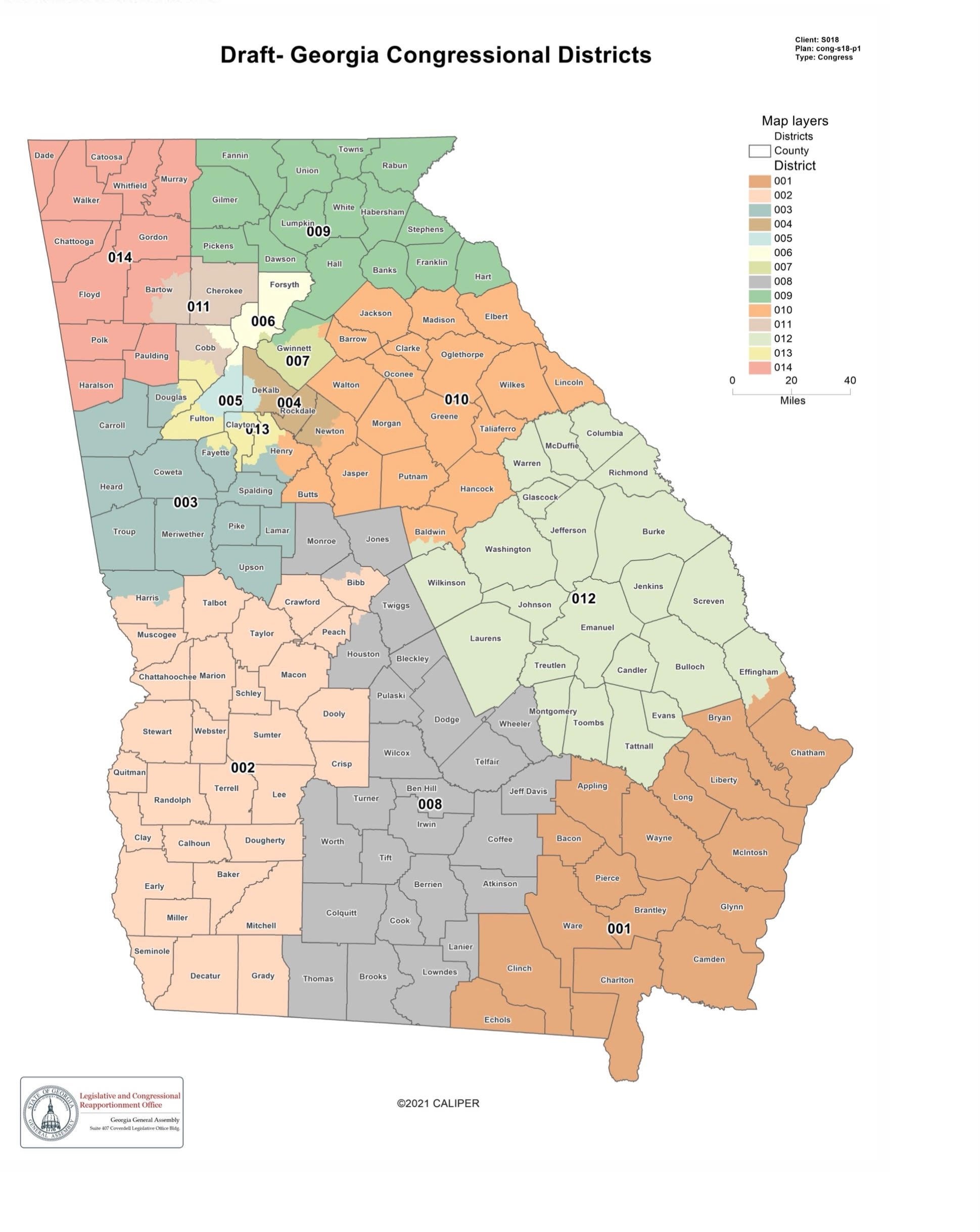Last month, the Georgia Senate’s Republican leadership released its first proposal for Congressional redistricting in 2022. Perhaps unsurprisingly after losing the 2020 presidential election and both U.S. Senate seats to Democratic candidates, Republican legislators drew a favorable map for themselves, hoping to grow their current two seat advantage among Georgia’s House Representatives.
The tentative plan focuses on the 6th and 7th Congressional districts — Atlanta’s suburban areas that flipped from Republican to Democratic hands in 2018 and 2020, respectively. The new map effectively concedes the formerly competitive 7th district by “packing” it with Democratic-leaning voters, but changes the 6th into a Republican-leaning district.
In theory, this would send nine Republicans and five Democrats to the House of Representatives from Georgia as a result of the 2022 midterm elections. (The current split is eight Republicans and six Democrats.) This, in a state that voted to elect the current President by a mere .13% margin. Should a state this closely divided be so unevenly represented in Congress?
MORE: Augustans Offer Feedback at Redistricting Meeting
Of course, there are bigger implications than just Georgia’s Congressional representation. Republicans nationwide are looking to take control of the House, where Democrats currently hold a slim eight-seat majority. In any state where partisan legislatures can unilaterally draw new maps, Republicans and Democrats are hoping to shape them to their advantage.
But is this the best way to determine representation? Should we all be content to relinquish this power to whatever political party happens to be in charge of our state following a Census?
[adrotate banner=”55″]
Several states say no, and the trend is growing. Over the next year, 11 states will use redistricting commissions to draw and approve their Congressional maps — up from six just a decade ago. These commissions have rules governing partisan balance. In some states, they must have an equal number of Republicans and Democrats; in others, they must also have representation from independents and/or third-party members. Additionally, all but three are independent commissions, prohibiting legislators or other elected officials from participating.
These 11 states, plus five more, will also use redistricting commissions for their state legislative maps — that is, for state senate and state house (or assembly or delegate) districts. This is important because state legislative maps are often more gerrymandered than Congressional ones, possibly because they receive less scrutiny and oversight from federal courts and lawmakers.
For instance, Athens-Clarke County is one of the most Democratic-leaning areas in Georgia, but the districts that encompass it are drawn in such a way that two out of three of its state house representatives and both of its state senators are Republican.
MORE: Opinion: Let’s Get Augustans Out of Prison and Into Treatment
And even in many of the 34 states where redistricting power resides with the state government, advisory and backup commissions are growing more popular. Advisory commissions come up with maps for legislators to approve or veto, while backup commissions draw maps in the event that the legislature cannot approve its own.
But not in Georgia.
In Georgia, state and Congressional districts are drawn by the legislature and can be approved by a simple majority in both houses, subject to the governor’s signature. If one party holds both houses and the governor’s mansion, there is very little to hold it back from drawing district lines according to partisan political ambitions.
[adrotate banner=”15″]
“So what?” you might say, “I’m a Republican, and if the legislature wants to fudge the lines to keep Democrats out of power, that’s all the better.”
Okay, sure. But Georgia’s not a reliably red state anymore. It’s purple and growing bluer every day. And that’s based on more than just the 2020 elections. According to the 2020 Census, Georgia’s rural, mostly conservative population has been shrinking, and its urban, mostly liberal population has been exploding over the past 10 years. Just think of the growing film industry in Atlanta, drawing workers from Hollywood. And think of all the efforts to grow the tech industry in Augusta. That’s a very diverse, young, and mostly liberal demographic overall.
Stacey Abrams lost the Governor’s race in 2018 by less than 55,000 votes. Joe Biden won Georgia’s electoral votes two years later by less than 12,000. Let’s say that trend continues. When the 2030 census comes around, do you want to take the chance that Democrats alone will control redistricting? Or would you rather have an independent, bipartisan (or even multi-partisan) commission in place to make sure you are adequately represented?
If you want the Georgia General Assembly to take the idea of redistricting reform seriously, now is the time to make your voice heard. A state legislative special session for redistricting will begin on Nov. 3. This is when they will draw up and vote on Congressional and state legislative maps for the next decade. You can submit your public comments here. You can also reach out to your state representatives with help from this site.
Marcus Plumlee is a Columnist for The Augusta Press. Reach him at mplumlee87@icloud.com











